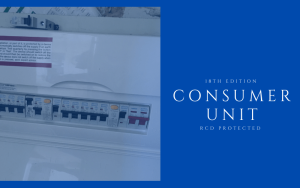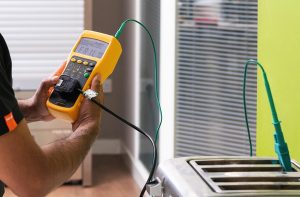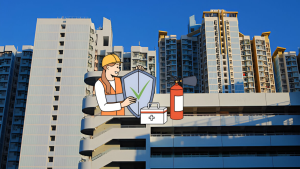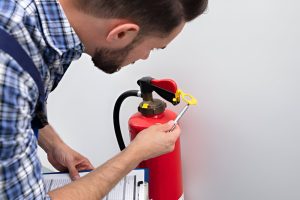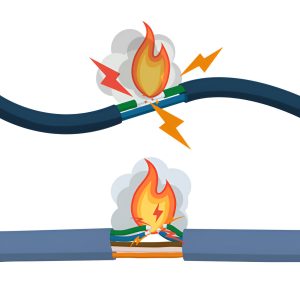As a fire safety risk assessor, I’m often asked about the importance of annual fire risk assessments for landlords.
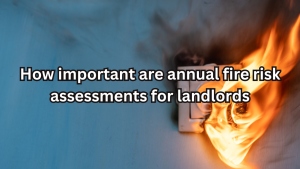
It’s an issue that mustn’t be taken lightly; not only is it essential to ensure the safety and wellbeing of tenants, but there are also legal requirements in place which should not be overlooked.
In this article, I’ll explain why annual fire risk assessments are so important and how they can help landlords fulfill their obligations.
Understanding Fire Risk Assessments
As a fire safety risk assessor/engineer, it is my duty to ensure that landlords are well-informed about the importance of annual fire risk assessments. Fire prevention and evacuation plans should be required for all rental properties, as these measures can help save lives in an emergency.
The first step when conducting a fire risk assessment is to identify potential sources of ignition and any combustible materials which may contribute to the spread of flames or smoke. Sources could include faulty wiring or appliances within the property such as boilers, cookers or heaters.
The landlord must also consider other factors such as how many occupants live there, their ages and any disabilities they may have, as this will determine if extra precautions need to be taken into account during an evacuation plan.
Once any risks have been identified, steps can then be taken to reduce them through appropriate maintenance work which might include regular testing of alarm systems, keeping escape routes free from obstructions and ensuring furniture meets flammability requirements.
It’s important for landlords to stay up-to-date with current legislation on fire safety so that their tenants remain safe at all times. By taking proactive measures now you can avoid potentially devastating outcomes in the future.
Establishing Fire Safety Protocols
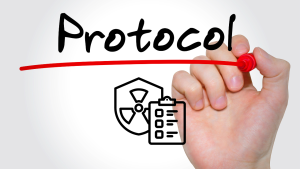
Fire safety protocols must be established to ensure the protection of tenants, property and legal compliance. As a fire safety risk assessor/engineer, it is my job to monitor compliance and develop plans for landlords that will help them meet their obligations under law.
To do this, I conduct an annual fire risk assessment which identifies any potential risks or hazards before they can cause harm. This includes inspecting all areas of the building such as kitchens, bathrooms, hallways and stairwells; assessing whether any furniture or appliances present a fire hazard; checking if smoke alarms are in working order; considering how well-maintained the building is with regards to fire safety regulations; and analysing escape routes should a fire occur.
By establishing these protocols, I am able to provide guidance on corrective measures that need to be taken so that landlords are not held liable should something go wrong. These include:
- Installing appropriate means of detection (smoke detectors):
- Ensuring devices meet relevant standards
- Testing regularly for functionality
- Making sure there’s adequate coverage throughout the building
- Establishing evacuation procedures:
- Developing emergency exit paths from each room
- Providing training sessions for staff/tenants on what actions to take during an emergency situation
- Mapping out where equipment like extinguishers and hose reels are located
- Assessing storage capacity:
- Identifying combustible materials used for packing material or stored goods
- Monitoring levels of flammable liquids (petrol, paint etc) being kept on site
These essential steps help me achieve my ultimate goal – providing peace of mind by helping landlords adhere to necessary fire safety regulations. Through proper monitoring and developing comprehensive plans tailored towards individual needs, I’m confident we can protect people living in rented properties while ensuring landlord obligations are met.
Identifying Fire Hazards And Risks
Every year, landlords are tasked with the responsibility of preparing and implementing fire risk assessments. As a fire safety risk assessor or engineer, it is important to understand how to identify potential fire hazards and risks in residential buildings.
Statistics gathered from the National Fire Protection Association (NFPA) show that roughly 75% of civilian deaths caused by fires occur in homes without working smoke alarms. This serves as an example of why identifying possible fire hazards and risks should be taken seriously when assessing any property for tenant safety.
When evaluating a building for potential fire hazards, one should consider conducting a thorough inspection of all areas including electrical wiring, fuel sources such as combustible materials, heating systems, ventilation systems, exits/entrances and evacuation plans.
It is also necessary to take into account measures like insulation or flame-proofing which can help reduce the spread of flames throughout a building if a blaze does start.
By taking these steps during the annual assessment process, landlords can ensure their tenants remain safe from harm due to fires. The key takeaway here is that failure to recognize and address issues related to fire on time can have devastating consequences for those living in rental properties – making regular inspections essential for reducing this threat.
Implementing Fire Safety Solutions
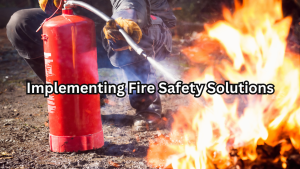
I’m always keen to ensure landlords are aware of their obligations when it comes to fire safety. Developing fire safety plans and installing fire alarms and smoke detectors can provide peace of mind that the property is safe and up-to-date.
I also recommend landlords check their fire doors annually, to make sure they’re in good condition and up to the necessary standards. This can help identify any issues before they become a problem.
It’s important to understand the risks and make sure the property is safe and secure.
I’m committed to helping landlords understand the importance of fire safety and implementing the right solutions.
Developing Fire Safety Plans
When evaluating the risk of fire, it’s important to develop an effective safety plan. Fire safety engineers and assessors need to be thorough in their investigations and testing systems. That means taking into account all possible ignition sources within a property, identifying any potential risks posed by these sources, and then implementing solutions that mitigate those risks.
Testing of preventative measures should also include regular checks of smoke alarms, emergency lighting, and evacuation routes. It isn’t enough just to install these devices – they must be regularly maintained in order for them to serve their purpose correctly.
Once the initial investigation has been conducted, landlords are responsible for ensuring that adequate records are kept so that future assessments can take place with relative ease. This will ensure compliance with applicable legislation as well as providing peace-of-mind for tenants that their safety is being taken seriously.
The importance of developing an appropriate fire safety plan cannot be overstated; doing so allows both landlords and tenants alike to rest assured that all necessary steps have been taken for mitigating the risk of fire onsite.
Installing Fire Alarms And Smoke Detectors
Once the safety plan is created, it’s time to start implementing fire safety solutions. Fire alarms and smoke detectors are critical components of any good system; they provide early warning when a fire breaks out, giving people in the building more time to evacuate safely.
In order to ensure that these devices are working properly, testing requirements must be met on an ongoing basis. This usually involves checking the batteries every few months, as well as performing a full system check at least once per year.
Proper installation is also key for optimal performance – this means making sure all connections are secure and sensors are positioned correctly throughout the property. Alarm systems should also be interconnected so that if one detector goes off, they all do simultaneously.
With proper implementation and regular maintenance, landlords can have confidence knowing their tenants will stay safe in the event of a fire emergency.
Ensuring Fire Doors Are Up-To-Date
Once the necessary alarms and detectors have been installed, it’s time to make sure that fire doors are also up-to-date.
Fire doors are designed to slow down the spread of smoke and flames throughout a building, providing vital extra seconds for people to escape safely in an emergency situation.
To ensure these doors meet all complying regulations, regular maintenance is essential – this includes inspecting door frames, hinges, seals and closers on a routine basis.
Preventative measures such as adding intumescent strips or automatic closing devices can help too; they provide an additional layer of protection by making sure that the doors close securely when activated by a fire alarm system.
All landlords should take steps like these to further protect their tenants in case of a fire emergency –it’s not just about having working safety systems in place but also ensuring they function properly at all times.
Inspecting Fire Safety Equipment
As a fire safety risk assessor, it is essential to inspect all of the relevant equipment and systems within a property. This includes installing suitable fire alarms as well as testing any existing systems that are in place.
When inspecting fire safety equipment, I always start by assessing the quality of the installation or upgrade work. Are there appropriate signs displaying where smoke detectors are located? Has wiring been appropriately installed with no visible damage caused during works? Is there sufficient protection from combustible materials (e.g. bedding) near heat sources such as radiators?
It is also important for me to identify any maintenance issues when carrying out an inspection. Have all batteries been replaced recently? Are alarm bells free from dust buildup? Are emergency lighting units functioning correctly and have correct signage displayed for occupants to identify escape routes quickly and easily in event of an emergency situation occurring?
The following steps should be taken from my assessment:
- Installing Alarms:
- Check manufacturer instructions/standards prior to installation
- Ensure device has adequate power supply e.g. electricity / battery backup
- Confirm position & spacing between devices
- Testing Systems:
- Test all audible alarms before completing the job
- Perform regular tests on smoke detector sensitivity levels
- Keep records of all test results & present them upon request
With these tips in mind, landlords can ensure their properties remain safe throughout the year; not just meeting legal requirements but providing peace of mind for everyone involved with the building!
Documenting Fire Risk Assessments
Documenting fire risk assessments is a crucial part of ensuring accuracy and developing processes for landlords. As the old saying goes, ‘a stitch in time saves nine,’ so it’s important to be as thorough and comprehensive as possible when conducting these reviews.
Keeping detailed records of any potential fire hazards, areas of concern, and recommended remediation measures can help landlords develop a proactive plan to address issues before they become serious problems.
It’s essential that all findings from the assessment are documented accurately in order for the landlord to comply with relevant regulatory requirements. This includes properly labeling any hazardous materials which may cause a fire hazard or require special handling procedures.
Additionally, photos should be taken both before and after any remedial action has been applied – this will provide proof that something has been done if there is ever an inspection by local authorities.
To ensure safety going forward, it’s also critical that regular inspections are conducted at least once a year and noted on the original documentation. This helps identify changes or new risks which could have arisen since the last review took place, allowing landlords to take appropriate steps towards mitigating them in a timely manner.
Training Staff On Fire Safety
As a fire safety risk assessor/engineer, it is important to ensure that landlords are properly trained in fire safety. This involves teaching methods and techniques to help them better understand the risks of fires and how they can take steps to protect their tenants from harm.
One of the most effective ways to do this is through regular fire drills. Fire drills provide an opportunity for everyone onsite to become familiar with the emergency exit routes and other procedures should a fire arise. They also allow staff members to practice these skills so they will be prepared if ever faced with a real-life situation. In addition, running regular fire drills allows landlords to evaluate any potential weaknesses or areas where additional training may be required.
It is essential for all staff who work at properties covered by your assessment to have up-to-date knowledge about fire safety protocols, including evacuation plans and what action should be taken when a warning system goes off during a drill or in real life. To ensure proper understanding, you need to be confident that employees have received adequate instruction prior to carrying out the exercises.
With clear guidance and thorough training materials, landlords can rest assured that their team are knowledgeable enough to keep their tenants safe in case of an emergency.
Updating Fire Risk Assessments
As we have discussed, training staff on fire safety is essential for any landlord. But this alone is not enough to ensure the safety of tenants and property. Landlords must also review relevant regulations and update their policies accordingly in order to create a safe environment. This can be done through conducting an annual fire risk assessment.
Conducting an up-to-date fire risk assessment should include several tasks. Firstly, it’s important that all areas are inspected, including accessible roofs and equipment storage rooms.
Secondly, landlords should consider the layout of escape routes, such as hallways or staircases; these need to be clearly marked and free from obstructions.
Lastly, appropriate firefighting equipment needs to be provided where necessary – such as extinguishers, smoke alarms, and sprinkler systems – then checked regularly by certified technicians who understand how to identify potential risks within a building structure.
By implementing robust procedures for reviewing regulations and updating policies based on current standards, landlords can rest assured their buildings are compliant with local laws – thereby reducing their liability when it comes to fire safety requirements.
Understanding Legal Requirements
I’m a fire safety risk assessor/engineer and I’m here to discuss the legal obligations and fire safety regulations for landlords.
As a landlord, you’re legally obligated to carry out a fire risk assessment on your property at least once a year. This assessment should be done by a professional, like myself, and is designed to identify fire hazards and risks. It also involves making sure that any fire safety equipment, like alarms and extinguishers, are fit for purpose and in good working order.
I’ll also be able to advise you on any measures you need to take to protect your tenants and comply with fire safety regulations. The fire risk assessment must meet the standards of the Regulatory Reform (Fire Safety) Order 2005. This includes making sure the building is structurally sound and all necessary safety measures are taken.
Legal Obligations
As a fire safety risk assessor/engineer, it’s my job to understand exactly what landlords are legally obligated to do when it comes to fire prevention and risk management.
First off, they need to ensure that any property they own or manage is kept up-to-date with the latest regulations concerning fire safety. This includes conducting regular assessments of all potential risks associated with their premises – from exits and emergency lighting systems to smoke detectors and alarm activation points.
In addition, it’s also important for landlords to be aware of other legal obligations related to fire safety such as ensuring appropriate signage is in place throughout the building. Furthermore, if rented properties contain combustible materials like furniture or carpets then these must meet current standards including having fire resistant labels attached where necessary.
Ultimately, in order for landlords to meet legal requirements surrounding fire safety, annual risk assessments should become an essential part of their maintenance routine. If done correctly this can help identify areas of concern before they become more serious problems and ultimately safeguard both tenants’ lives and the landlord’s liability.
Fire Safety Regulations
When it comes to fire safety regulations, there are a lot of things landlords must be aware of beyond just ensuring their premises are up-to-date with the latest standards.
They also need to ensure that any combustible materials such as furniture or carpets have the appropriate fireproofing materials and labels attached.
Additionally, they should put in place various fire prevention strategies like installing smoke detectors, emergency lighting systems, and alarms – all of which can help protect tenants’ lives and reduce liability for the landlord.
Ultimately, by staying informed about these key rules, landlords can make sure they’re doing everything possible to keep their properties safe from potential fires and other disasters.
Fire Risk Assessment Standards
When it comes to mitigating the risk of fire, one of the most important steps for landlords is to perform a thorough Fire Risk Assessment. This involves looking at both existing and potential risks within their property and devising solutions that can help reduce or eliminate them.
As a fire safety engineer, I recommend that this assessment be done on an annual basis to ensure all areas are up-to-date with the latest regulations. In addition, landlords should also consider implementing additional fire prevention measures such as regularly testing smoke detectors and emergency lighting systems, installing sprinklers where necessary, and having proper signage in place throughout their buildings.
By taking these proactive steps towards risk mitigation, they will not only keep tenants safe but also lessen their liability if anything were to occur. A well thought out plan focused on fire prevention combined with regular assessments is key to ensuring your premises remain compliant with legal requirements.
Ensuring Fire Safety Compliance
As a fire safety risk assessor or engineer, it is essential to ensure compliance with local and national regulations when assessing the potential for fires. This includes developing and maintaining robust fire prevention plans that are appropriate for each property in question.
There are several key steps that will help landlords reduce their exposure to risks associated with fires:
- Conducting visual inspections of the building’s structure, including looking out for any signs of combustible materials such as wood, paper, plastic etc., that could easily catch alight if exposed to heat sources;
- Checking smoke detectors and alarms at regular intervals, ensuring they are working effectively;
- Installing sprinkler systems where necessary;
- Ensuring all electrical wiring is up to code and regularly maintained by qualified professionals;
- Carrying out staff training on how to react quickly in emergency situations.
These measures can go a long way towards preventing fires from occurring in the first place. They also lay down clear expectations regarding what should be done if a fire does occur – allowing people living in the premises to evacuate safely and minimize damage.
Ultimately, these efforts constitute an important part of any landlord’s responsibility toward protecting tenants from harm due to potential fire hazards.
Frequently Asked Questions
How Often Should A Fire Risk Assessment Be Conducted?
As a fire safety risk assessor/engineer, I cannot stress enough the importance of a regularity check to ensure that all applicable safety regulations are met.
By conducting an annual fire risk assessment for landlords, you can identify potential risks and take steps towards rectifying these issues before they become dangerous.
For example, in 2017 ABC Landlords conducted yearly fire risk assessments which indicated a need to upgrade their smoke alarms; by doing so they were able to reduce the likelihood of serious harm should a fire break out on their property.
Without this type of proactive approach it would be difficult to understand how safe your building is at any given time.
What Type Of Fire Safety Equipment Is Required To Be Inspected?
When conducting an annual fire risk assessment, it is important to inspect all necessary fire safety equipment.
Fire codes and safety protocols require that landlords inspect extinguishers, alarms, automatic sprinkler systems, emergency exit pathways and more.
As a certified fire safety engineer, I can assure you that these inspections are imperative in order to keep tenants safe from potential fires.
How Can Landlords Ensure That Their Staff Are Adequately Trained In Fire Safety?
As a fire safety risk assessor or engineer, I recommend that landlords ensure their staff are adequately trained in fire safety by conducting regular fire drills and developing evacuation plans.
Fire drills should be done at regular intervals to train staff on how to evacuate the premises quickly and safely during an emergency situation.
Additionally, it is essential for landlords to create comprehensive evacuation plans which outline the specific escape routes that each employee must take in case of a fire.
This will help minimize confusion and increase the chances of escaping without harm during an actual emergency.
Are There Any Special Legal Requirements Related To Fire Safety That Landlords Need To Be Aware Of?
When it comes to fire safety, landlords need to be aware of the legal requirements that are in place.
This includes knowing and understanding any applicable local building codes or other ordinances related to fire safety, as well as meeting all relevant national safety standards.
Having a thorough knowledge of these regulations can help ensure that you’re able to provide safe living conditions for your tenants, by having the necessary measures in place such as sprinkler systems, smoke alarms and proper exit routes.
It’s essential that landlords stay up-to-date on current laws and best practices related to fire safety so they can protect their property and those who live within it.
How Can Landlords Keep Their Fire Risk Assessments Up To Date?
Ensuring compliance with fire safety regulations is a must for landlords, and keeping fire risk assessments up to date should be part of their regular routine. Fire preparation not only helps protect tenants from danger but also keeps the landlord safe from legal repercussions if an emergency occurs.
As a fire safety risk assessor/engineer I advise that landlords review their assessment records annually to ensure they are meeting their obligations in terms of staying compliant and protecting their occupants. Regularly checking and updating your fire preparations will help you stay on top of any changes in legislation or building modifications that may have occurred since your last assessment.
Conclusion
As a fire safety risk assessor, I can assure landlords that an annual assessment of their property is essential for the safety and well-being of everyone living in or visiting their building.
With regular inspections, you’ll be able to spot any potential risks before they become hazardous issues.
It’s like performing maintenance on your car – if you don’t check it regularly, small problems can quickly snowball into much bigger ones down the line.
By taking appropriate measures to stay up-to-date with fire regulations and training staff in fire safety protocols, landlords will have peace of mind knowing that their buildings are well protected from the threat of fires.
Having an effective fire risk assessment provides not only legal protection but also invaluable security – it’s a safeguard against disaster waiting to happen.



